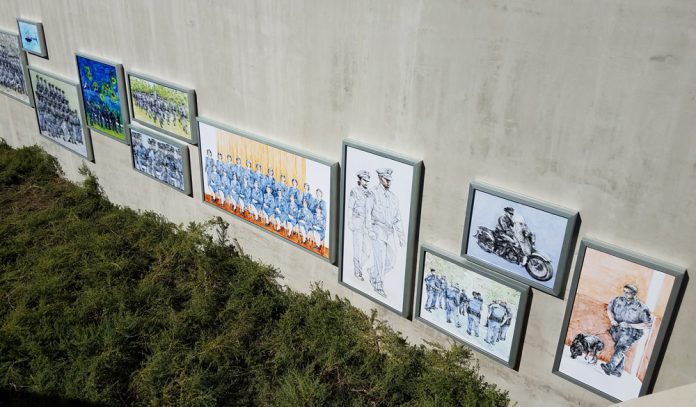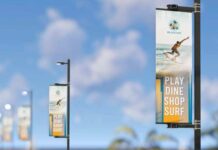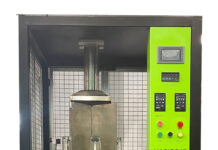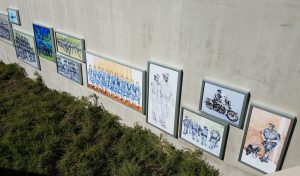 The Los Angeles Police Department (LAPD) Training Academy is the latest site where sign industry know-how and engineering contribute to artistic endeavors.
The Los Angeles Police Department (LAPD) Training Academy is the latest site where sign industry know-how and engineering contribute to artistic endeavors.
California-based artist Deborah Aschheim was commissioned to create art for the space that would connect new generations of law enforcement officers with the history of the LAPD. Her work consisted of twenty-two full-color and black-and-white panels, each a different size. These pieces were installed on an outdoor concrete wall that is seventy-eight feet long and varies in height from eighteen to twenty feet.
All of the panels feature Aschheim’s watercolor drawings translated into powder-coated metal. Fourteen of the watercolor artworks have a second layer of tempered glass with a black line drawing that “floats” above the color layer.
Aschheim collaborated will Sign Effectz, Inc., a full-service custom sign shop in Milwaukee, Wisconsin. She had worked with the company in the past on a number of her projects.
“Our main goal is to help professional artists like Deborah see what’s possible through our enthusiasm for materials and engineering,” says Owner Adam Brown. “We helped show her that what she wanted was achievable.”
“Even on a project like this, which involved two other fabricators (the specialized printers), my first thought was still to call Sign Effectz to help engineer a unique installation that doesn’t look like anything people have seen before,” says Aschheim. “[Brown] really loves art and inventing creative solutions to the engineering and design of my work. He is much more than a fabricator.”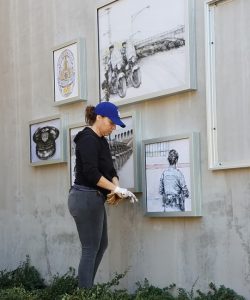
(Note: This project also had personal appeal for Brown. His father is retired from a long career in law enforcement. He served as a Milwaukee Police Officer and as Deputy Sheriff in Ozaukee County, Wisconsin.)
Brown’s process began by digging into the project budget and designing materials and methods to fit the project needs. Sign Effectz also explored different custom frame structures to support the artwork—from totally custom to “off the shelf” products.
Sign Effectz stayed true to Aschheim’s original concept with a few tweaks along the way.
They knew the finished product had to be cleanable and accessible from the backside of the panel. They also had to factor in sun/UV exposure, rain, and insects, as well as its ability to withstand seismic activity that’s common in the region.
The first stab at the costs of custom-run products came in higher than desired. “In the sign world, there are a large number of very diverse and qualified resources. Leveraging these resources is important in our process,” comments Brown.
The end-result is a hybrid solution: a customized SignComp™ aluminum extrusion made for a durable and architecturally pleasing frame system for attaching the artwork to the wall and lining up the two layers of material. The modifications to the panel support details of the extrusion allowed for the tight tolerance spacing between the two panels.
The project team modified the support channels where the glass mates with the aluminum using special EPDM gasket material.
The frames were finished using a Class 2 clear anodizing process, one of the best and most durable finishes for aluminum. The glass was manufactured as 1/4-inch-thick and was tempered to strengthen it and make it a safer product (like the windshield of a car).
Display Type #1 features a SignComp Extruded Aluminum Wall Mount Retro Body #2042 and hingeable Retainer #2052 forming a display box showcasing a single powder-coated aluminum panel of a particular rendering.
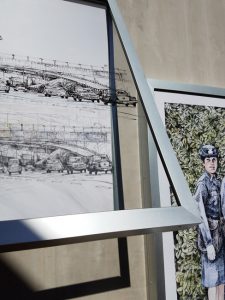 Display Type #2 features the same SignComp Aluminum Extrusions modified by Sign Effectz layering a clear tempered glass with printed black outlines of one particular image over a powder-coated aluminum sublayer with a full-color rendering of the same image, creating a 3D optical illusion, enhancing the viewing experience.
Display Type #2 features the same SignComp Aluminum Extrusions modified by Sign Effectz layering a clear tempered glass with printed black outlines of one particular image over a powder-coated aluminum sublayer with a full-color rendering of the same image, creating a 3D optical illusion, enhancing the viewing experience.
Aschheim credits Adrian Esguerra of Sign Effectz, Inc., for providing informative and error-free production packages here. “Her artwork featured drawings of motorcycle and bicycle officers, squad cars, helicopters, and cadets from past eras. What makes the project stand out is the use of overlapping transparent line art over full-color photographs or sketches and getting a nice 3D effect,” says Esguerra.
A Little Bit of History
Brown has another personal connection with this project.
The first company he worked for was St. George Signs in Milwaukee. It was there that he experimented with ways to add dimension to artwork. That included using polycarbonate to add shadows on some of his own personal designs he created for his home.
Back then, designs were created by hand—everything from the graphic layout and cutting out a stencil to back spraying, cutting, and weeding. With today’s technology, these types of designs are prepared in 3D CAD software so the final products can be viewed before being manufactured (i.e., the shadow effect and spacing between the panels can be seen on screen), whether through printing or engraving.
Logistical & Technical Considerations
In order to give the artist more layout freedom on the twenty-two panels on the concrete wall, a full-scale pattern was plotted.
On site, they laid out the pattern on the ground first. There Aschheim could move it around as needed until she was comfortable with it. Then they mounted it in one piece onto the wall.
The technical and/or engineering details of the install had to be followed strictly, since the LAPD training academy is built into the side of a hill. The installation location (concrete wall) serves as a retaining wall, varying in height from eighteen to twenty feet high and filled with reinforcement bar, typically set two inches in from the face.
They drilled 1-1/2-inch-deep holes, using a redhead drop-in style anchor and adding Simpson Strong Tie brand acrylic anchoring adhesive to each mount location.
The installation site was down a flight of stairs, which required each panel to be hand-carried down the stairs. This was a bit nerve-racking to say the least.
The glass came from Montreal, was expensive, and was specialty printed. In preparation for this, the panels were all pre-assembled in Deborah’s California art studio. The Sign Comp Extrusion added stiffness to the glass panels, allowing for more secure handling. They also had to ensure a good set of the seals for each one to keep water and moisture out. Doing this work in a controlled environment was deemed best.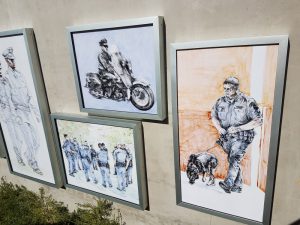
Brown reports several tense-filled moments working with the largest piece of glass (48-by-68 inches). “We put together the frame structure in the studio, and it flexes much more than one might realize,” he says, noting the installation went off without a hitch. “Glass requires a lot of special handling, especially when it’s that big and heavy. The solution was a lot of patience and stable movement.
“If I had a heart monitor on during the installation, I’m sure you’d get some good readings!”
Brown says that, when it comes to methods and materials, it’s about where to apply the knowledge, experience, and engineering. “Our main goal is to not overcomplicate things; in fact, simple is better!” he says. “We contributed to this the most before it reached the shop or the glass supplier in Montreal. Somebody on the team has to be good at value engineering, leveraging innovative thought, and resources. That’s our job, and it’s what we’re good at.”
“My family has pictures on the wall of relatives that go way back in time. The pictures help us remember them,” says Esguerra. “I feel like this project serves that purpose in a way for the LAPD—a rich history worth preserving.”
By Michael Quill
Photos: Sign Effectz, Inc.


